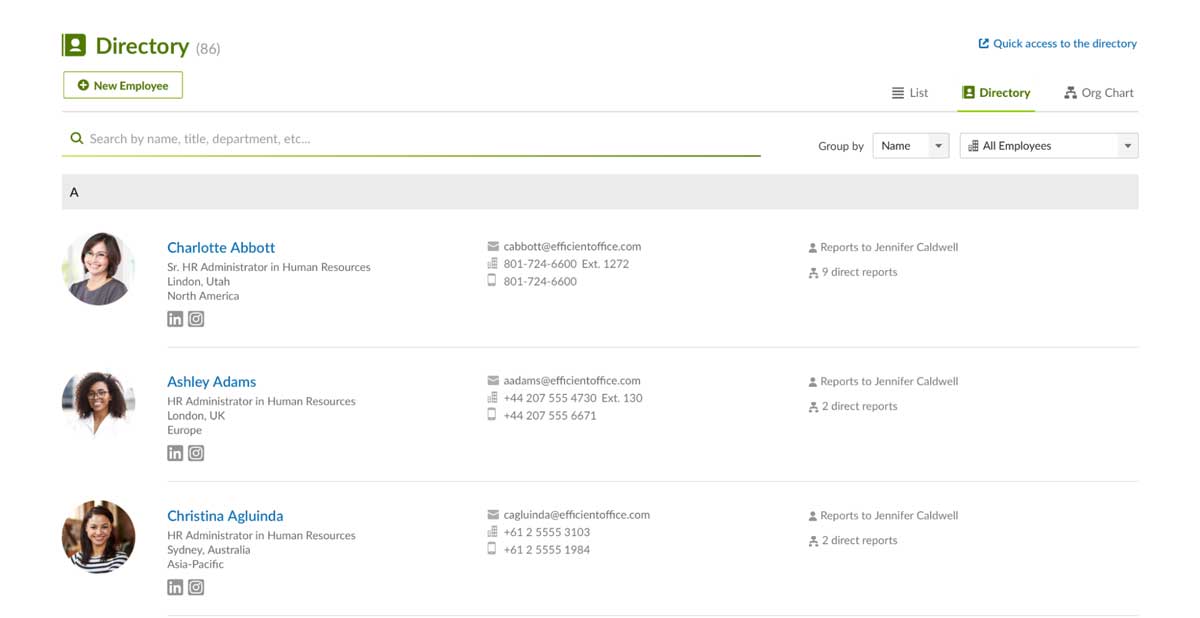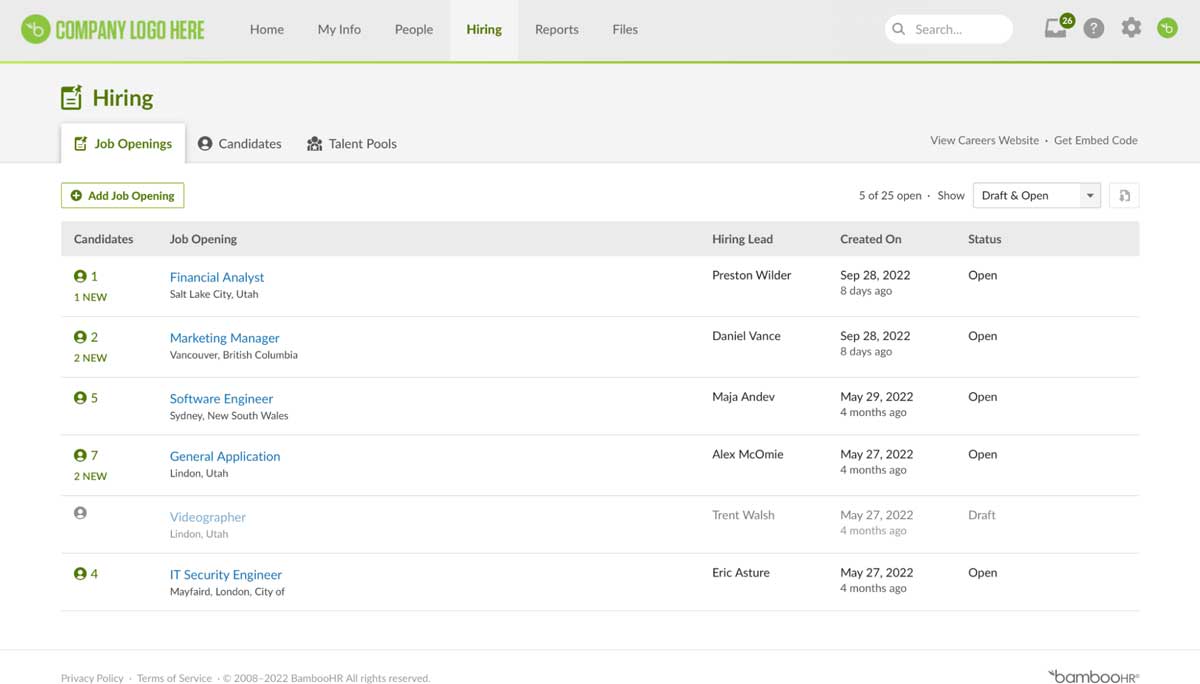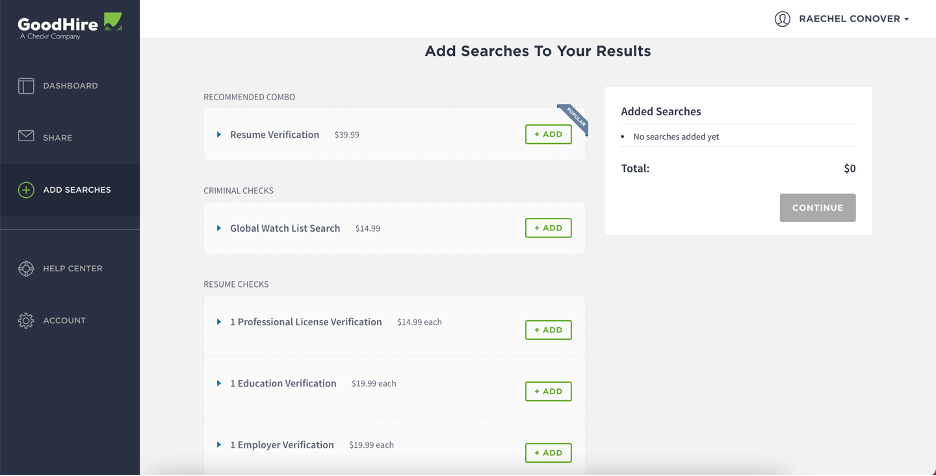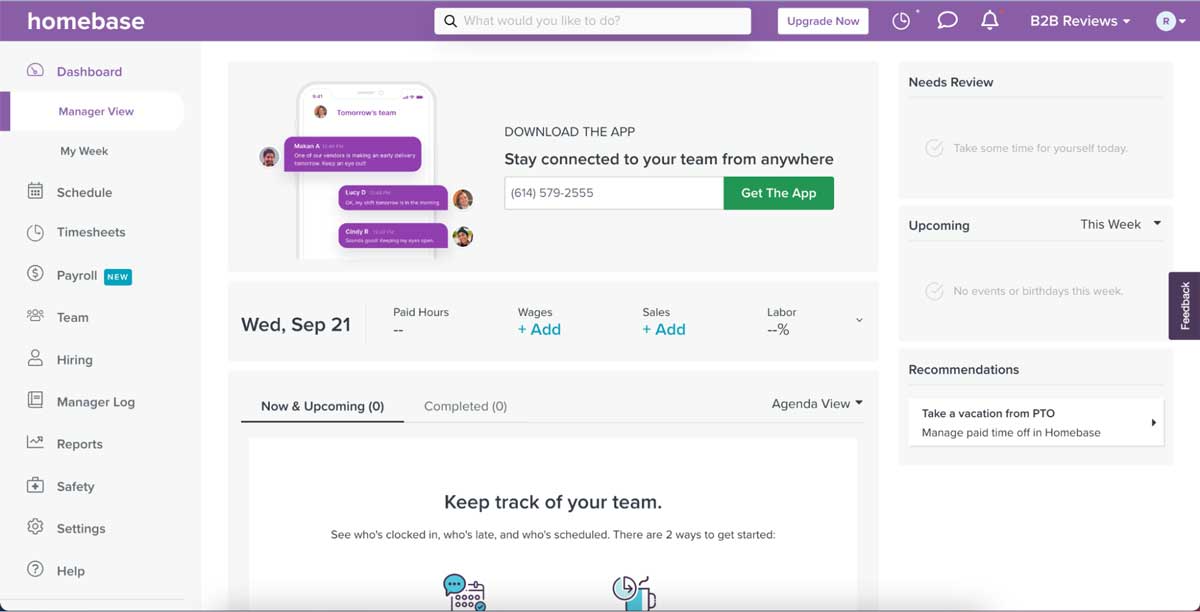We may earn money when you click on links to our partners. Advertiser Disclosure
From a business standpoint, HR wears many hats, from sourcing and hiring the right employees, to managing employee payroll, schedules, PTO, training, and development, to keeping the workplace safe and managing employee compliance.
It’s a lot, and the HR team is often stretched thin. Anything that helps free up time in the HR department is a worthy investment.
Enter HR technology like applicant tracking systems (ATS), payroll software, employee scheduling software, employee self-service portals, and more. We spoke with HR professionals and software experts to dive deeper into the various aspects of HR and learn where technology is working right now – and where the future of HR technology lies.
Employee Records
As you can imagine, employee record-keeping can be a full-time job itself. As a business, you are required to keep employee records, starting with hiring records for those that you do hire and those that you don’t.
What was once done as printed papers and boxes of employee files can now be done electronically and stored in the cloud. This trend will continue to grow in the coming years, and human resource information system (HRIS) software like BambooHR makes this especially easy on you.
“BambooHR helps organizations centralize their people data all in a single, secure platform,” says Kenny Latimer, Group Product Marketing Manager, BambooHR.
The reporting feature in BambooHR makes it easy to generate instant, detailed reports on almost any data with just a few clicks. You can choose from over 50 standard reports or create the custom reports that you need.

BambooHR employee directory including records and reporting. Source: BambooHR free trial.
Employee Portals
Self-service employee portals are a big trend in HR right now, according to the Society for Human Resource Management (SHRM), and will continue to grow in popularity to support the hybrid workforce.
Self-service employee portals take employee record software a step further and save you time updating employee data by allowing employees to do it themselves. BambooHR also offers this and allows you to give each employee individual access to their records, so you don’t have to stop what you’re doing every single time they want to change or view their records.
“Giving employees and managers self-service access greatly reduces the questions and requests coming to HR managers,” says Latimer.
Instead of having to answer questions about time-off accruals, document e-signatures, paycheck details, or team reporting structures, employees can find this information all directly within the platform.
“Giving employees and managers self-service access greatly reduces the questions and requests coming to HR managers”
HRIS Best Practices
Finally, when it comes to employee records, one common best practice is having a proactive plan in place for the lifecycle of your employee record. This includes routine evaluations of new technology, implementing them as needed, conducting backups and archives of records, a disaster recovery plan, and an outline of how and when old records will be disposed of.
Hiring and Onboarding
HR managers are responsible for sourcing, tracking, hiring, and onboarding the right candidate for each position. This process is the first contact an employee has with the company. If done right, a good hiring and onboarding process can positively affect employee retention rates – meaning less turnover and less need for constant hiring.
Talent Marketplaces
When it comes to hiring and onboarding new employees, there are several useful tools. The first and most significant emerging trend is talent marketplaces.
There are internal and external talent marketplaces, and both bring you a level of hiring success. External marketplaces attract talent outside of your organization, while internal platforms allow you to match your current workforce with open positions, project work, and learning opportunities to help staff grow and advance in their career path.

BambooHR hiring dashboard. Source: BambooHR free trial.
Applicant Tracking Systems
Enter applicant tracking systems (ATS). While some advanced ATS software can help you post and draw attention to your job postings, the main goal of an ATS is to help you keep track of incoming resumes and organize and rank candidates so you can make the best hiring decision.
ATS software such as BambooHR helps you from hiring through onboarding, helping you streamline and manage the process.
“Our solution helps HR professionals stay competitive in the job market by creating a positive candidate experience and speeding up the hiring process,” says Latimer.
When we surveyed HR professionals about their applicant tracking systems, they said project management features, integrations with payroll and other software, and its ability to be an all-in-one HR solution were top reasons for bringing the software into their organizations.
Electronic Signatures
One trend expected to grow in the onboarding process is replacing printed new hire paperwork with digital versions that can be signed electronically. With remote workers, the norm these days is doing the onboarding process from home.
One way that is made possible is signing documents using e-signatures – a feature that’s often included in HR software like BambooHR.
Employee Background Checks
As part of the onboarding process, you can require potential employees to get a background check. Employee background check software makes this automated and easy for you to manage. The best employee background check software integrates with your ATS software.

GoodHire background check software showing the background check options. Source: GoodHire candidate dashboard.
Employee Payroll Software
The most significant trend in payroll is more and more companies are moving to cloud-based payroll software.
“Payroll software helps HR professionals manage employee salaries, taxes, and benefits,” says Sreeram Sharma, Head of Human Resources at Qik-Chat. “It can automate tasks such as calculating pay, withholding taxes, and generating tax forms – which can save HR professionals time and reduce errors.”
Additionally, it allows companies to run payroll from anywhere at any time, positioning them to grow and maintain compliance easily.
“Payroll software helps HR professionals manage employee salaries, taxes, and benefits”
Employee Scheduling
Another growing trend is that workers want a hybrid and flexible schedule they can control themselves. To accommodate this, your employee scheduling software needs to be up to the task.
This means a mobile app and employee portal that employees can access from anywhere and take control over things like shift swapping, time tracking, and viewing time-off requests.

Homebase employee scheduling software manager’s dashboard. Source: Homebase free trial.
Employee Benefits Administration
When it comes to employee benefits administration software, companies seek to max out existing software. HR software companies like BambooHR and Rippling that offer core HR services and optional add-ons like benefits administration mean companies can get it all in one platform.
AI in HR Technology
Artificial intelligence (AI) is a growing technology trend across multiple industries, including HR. SHRM predicts that AI within HR technology will grow in 2023 to encompass recruiting, performance metrics, employee engagement, and identifying skill gaps in levels of workers.
There will also be more legislation and regulations on AI in HR software, with companies being required to report their hiring metrics to ensure AI practices are hiring fairly and unbiasedly.
Technology for the Hybrid Workforce
The hybrid workforce is here to stay. According to Zippia.com, workers like the flexibility to work outside of the office:
- 55% prefer to work remotely three days a week.
- 59% of employees will choose a company that offers hybrid options over those that don’t.
- 74% of U.S. companies using or planning to use a permanent hybrid work model.
“With many companies adopting a hybrid workforce model, HR professionals need technology that supports remote work and collaboration. This can include tools such as video conferencing, project management software, and cloud-based file storage,” Sharma says.
A Director of Talent Acquisition that we spoke to about ATS software particularly likes BambooHR and the collaboration tools it provides during the hiring and onboarding process.
The Bottom Line
As more and more companies shift to hybrid and remote work, the need for cutting edge technology will continue in order to make the job of HR professionals easier, while accommodating a changing workforce.
“By leveraging these HR technology tools, HR professionals can improve their HR processes, save time, reduce errors, and improve the employee experience. They can also better support a hybrid workforce and stay competitive in an increasingly digital world,” Sharma says.
In the end, HR is an industry that is constantly changing and evolving – and technology will continue growing and evolving with it.